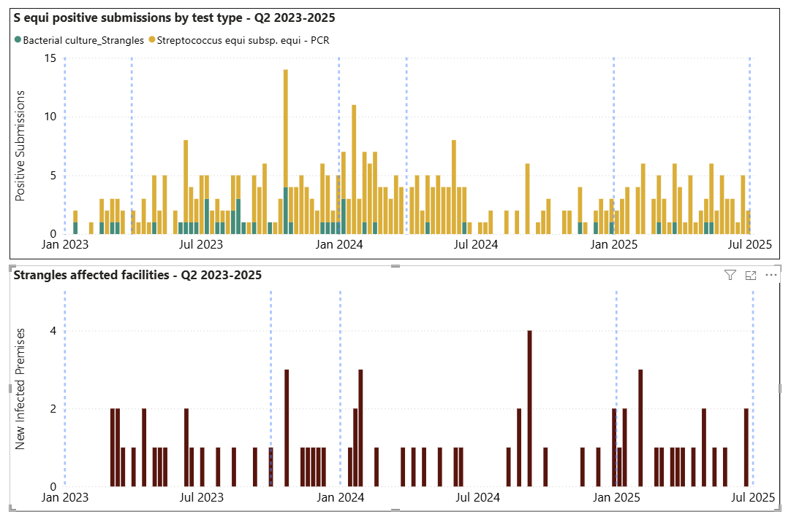Ontario Animal Health Network (OAHN)
Equine Expert Network
Quarterly Veterinary Report
BITS ‘N SNIPS (or “things we talked about on the network call”)
During our network call we discussed asthma due to wildfire smoke. Just a reminder that there are several resources on the OAHN.ca website that discusses wildfire smoke and horses.
Wildfires and Horse Health – Ontario Animal Health Network
We also discussed contaminated uteri in mares post Cesarian section that were treated with platelet-rich plasma. For more information see:
Cesarean section in 19 mares. Results and postoperative fertility. Juzwiak JS, Slone DE Jr, Santschi EM, Moll HD.Vet Surg. 1990 Jan-Feb;19(1):50-2.
You may have heard that Rocky Mountain Spotted Fever has been diagnosed in dogs that had been to Long Point. This is a zoonotic disease and it can be deadly to both dogs and people. Although horses are not generally thought to develop RMSF, the tick (American Dog tick/ Dermacentor variabilis) can be found on horses in Ontario and horses can be infected by the pathogen, Rickettsia rickettsii. Most infected horses are thought to be asymptomatic, however, there has been one equine case report where RSMF was suspected.
A Suspected Case of Rocky Mountain Spotted Fever in an Adult Horse in the Southeastern United States. Freese S, Sheats MK.J Equine Vet Sci. 2019 Jul;78:134-137.
During most quarters of the year, Ontario veterinarians report seeing horses with “fevers of unknown origin”. Researchers at Cornell university recently looked at the main pathogens in these FUO horses. See the infographic below for a summary of the article.
Although not present this quarter, we briefly discussed the increased number of Potomac Horse Fever cases already showing in Q3. See the infographic below for a summary of an article on Potomac Horse Fever in Ontario.
There was a confirmed case of Pigeon Fever (Corynebacterium pseudotuberculosis) in a pony in Oxford County earlier this year. The pony had shipped up from Florida and the abscess was positive on culture.
Molecular Detection of Pathogens in Equine Fever Cases (Fever of Unknown Origin)
Results from the Equine Fever Diagnostic Panel (EFDP), 2019-2023 Cornell University, Animal Health Laboratory
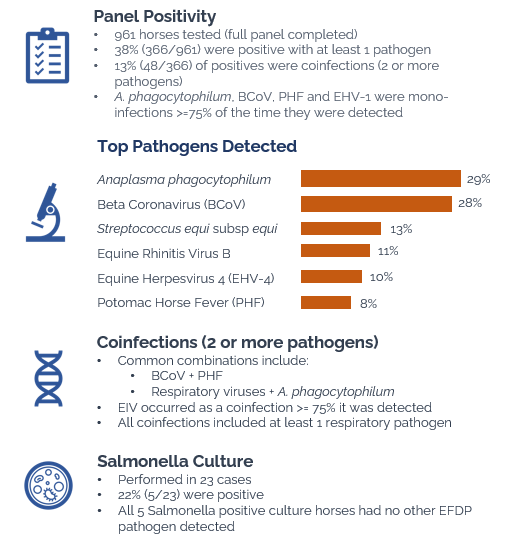
Potomac Horse Fever in Ontario (2015-2019)
Clinical, geographic and diagnostic aspects
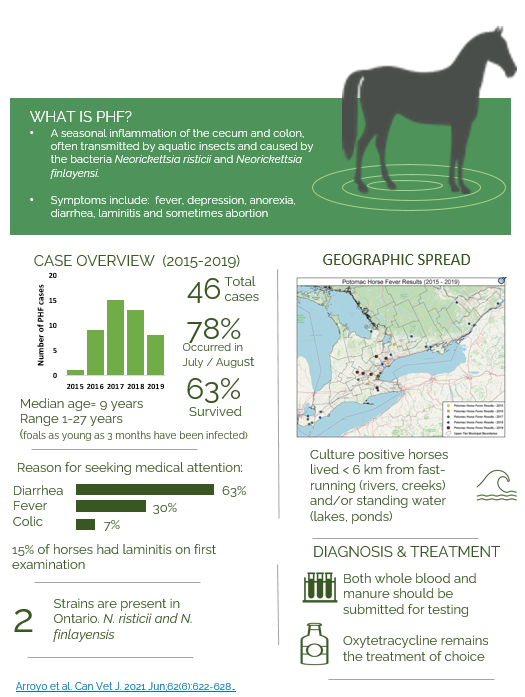
Network Member Reports
| Southwestern Region
(Melissa McKee) |
This quarter we saw significant increase in metabolic-associated laminitis and atypical tying up cases due to environmental conditions and lush pastures, Asthma cases flared due to poor air quality, and moisture- associated dermatitis (pastern dermatitis, vasculitis, rain rot, ) increased. For pastern dermatitis, the leg coverings (e.g. Equi-chaps have been useful). There was a slight increase in the number of surgically significant bone injuries in racehorses and riding horses (P1). It seemed like mares were late to start cycling and breeding back after foaling challenges. Strangles continues to simmer but is not a big concern right now. |
| Southern Ontario
(Jenna Donaldson) |
One thing we all noted this quarter was an increase in umbilical infections . Usually, we have a handful each year and are treated successfully but this year we had refer two for surgery . We didn’t have any multidrug uterine infections this year which was nice. Most MDR uterine infections have been associated with recovery from C-sections. We had two previously which culture Klebsiella sp. and were treated with dilute vinegar lavages and platelet-rick-plasma and both got pregnant the following year with no problem |
| Ontario Veterinary College
(Memo Arroyo) |
This quarter was dominated mostly by foals, postpartum mares, and colics. Happy to see very little hemorrhage post foaling, and not too many retained placentas. But we had a lot of foals; typically septic and NME foals and we saw a little unusual presentation in that foals did not appear systemically septic but had septic joints and/or osteomyelitis. They were difficult to treat as they were not responsive to typical antibiotics. Now doing more resistance studies to see what’s going on. As we move into spring we have had the earliest Neorickettsia (PHF) case yet (beginning of May) and are admitting an increased number of PHF cases. There are a lot of non-PHF colitis cases as well |
| AHL Pathology
(Emily Ratsep) |
|
| OMAFA
(Bukunmi Odebunmi & Alison Moore) |
Immediately Notifiable Diseases: Case Reports to OMAFA
West Nile Virus: No cases this quarter •First wild bird case 2025: May 26, 2025 (Whitchurch-Stouffville, ON) Eastern Equine Encephalitis virus: No cases the quarter •First equine case 2024: week of July 14th Equine Herpesvirus-1: There were 3 facilities affected by EHM due to EHV-1 in Q2. One 28 yo gelding with acute ataxia that was euthanized (Wellington County, nNP strain), a <24 hour old foal that was born weak an died (Wellington County, nNP strain) and a 3 yo gelding with acute onset ataxia that is recovering (Toronto region, NP strain).
Available from: Equine Disease Tracking Network v 2.1 (arcgis.com)
Strangles: During Q2 there were 7 new facilities managing Strangles for a total of 18 facilities YTD . There were 25 facilities affected by Strangles in 2024.
Available from: Equine Disease Tracking Network v 2.1 (arcgis.com)
Equine Influenza: There were 6 facilities affected by influenza in Q2 in Hastings, Wellington, Essex and Niagara. 5 of the facilities had horses competing in the barrel racing industry.
Q1 Equine Syndromic Surveillance: Graphs of disease syndromes based on samples sent for testing to the Animal Health Laboratory. This information is compiled based on the type of sample, test ordered, and key terms included in the submission history (if provided).
|
Please follow:
Outbreaks | Equine Disease Communication Center (equinediseasecc.org) for reported outbreaks!
Syndromic and AHL Laboratory Data Surveillance
Survey – Key points
- 17 Counties represented
- 69% equine, 15% equine and food animal, 8% equine and small animal, 8% referral practice
- 24% of veterinarians reported working with performance/Competition/Show horses , 22% with pleasure/backyard horses, 18% with foals, breeding and young stock, 14% racehorses, 10% with draft horses, 10% with mules/donkeys, and 2% with buggy horses.
- Increases in Q1 were noted for (foal): umbilical infections
- Increases in Q1 were noted for (adult): Asthma, Strangles, smoke inhalation (wildfires), surgical colics, urticaria. EMS / insulin resistance, FUO, anaplasmosis and Lyme disease, anhydrosis
New conditions or those without a diagnosis:
- Fevers of unknown origin which tested negative for EHV, influenza, anaplasmosis, PHF, coronavirus, hepacivirus, rhinovirus A/B and streptococci sp.
- Two older horses with glaucoma, one of which was likely secondary to ERU and one primary glaucoma.
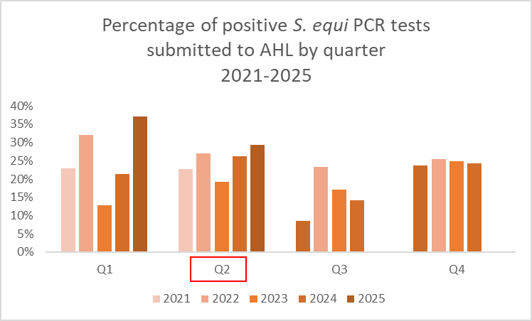
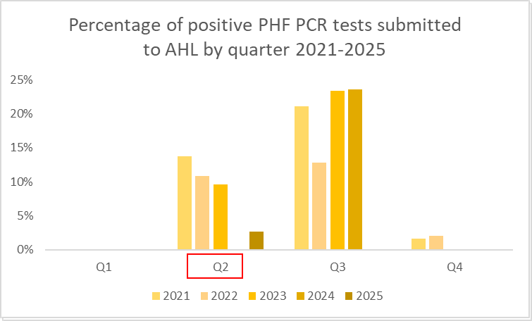
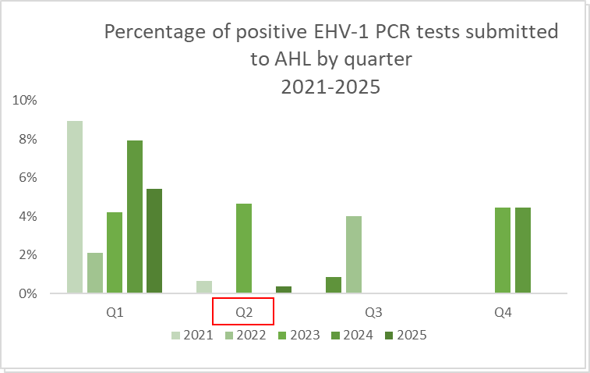
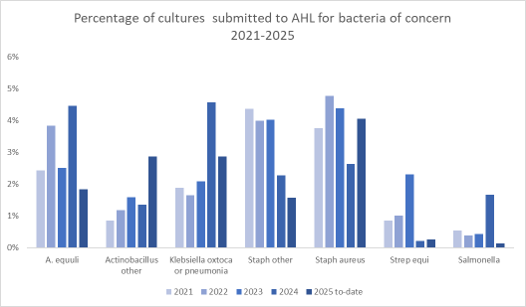
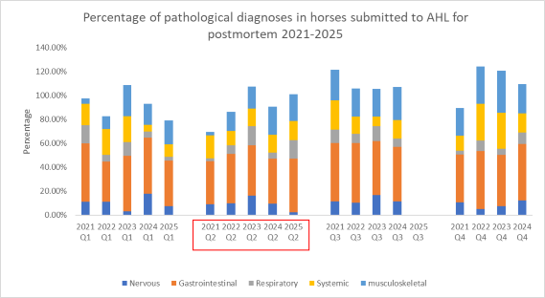
Equine Research from Ontario and Around the World
Researchers in Ontario
Identifying insulinemic responses of ID horses offered varying levels of NSC and meal-sizes. Kerley BS, Harris P, Jacquay E, Askins M, McClendon M, Adams AA.J Equine Vet Sci. 2025 Aug;151:105638. doi: 10.1016/j.jevs.2025.105638. Epub 2025 Jun 29.
Mosaic arthroplasty in equine stifle and fetlock joints: A retrospective study of 31 cases between 1998 and 2023. Pál Z, Tuska P, Vásárhelyi G, Hangody L, Hurtig M, Kaposi AD, Bodó G.Vet Surg. 2025 Jun 27. doi: 10.1111/vsu.14296. Online ahead of print.
Exploring the operational logistics of implementing isolation protocols at equestrian facilities. Turcotte GK, O’Sullivan TL, Spence KL, Winder CB, Greer AL.Prev Vet Med. 2025 Sep;242:106592. doi: 10.1016/j.prevetmed.2025.106592. Epub 2025 Jun 3.PMID: 40494149 Free article.
Performance horses as a model for exercise-associated cardiac arrhythmias and sudden cardiac death. Avison A, Physick-Sheard PW, Pyle WG.J Mol Cell Cardiol Plus. 2025 May 9;12:100452. doi: 10.1016/j.jmccpl.2025.100452. eCollection 2025 Jun. Free PMC article.
Blood and Peritoneal Lactate, Ratio and Difference, and Peritoneal Lactate to Total Solids Ratio for Detection of Intestinal Strangulating Obstructions in Horses. Parra-Moyano LA, Cedeño A, Darby S, Johnson JP, Gomez DE.J Vet Intern Med. 2025 Jul-Aug;39(4):e70121. doi: 10.1111/jvim.70121.PMID: 40448701 Free PMC article.
The presence of acylated homoserine lactones and diffusible signal factor in bronchoalveolar lavage fluid from horses with clinical exacerbation of severe equine asthma. Mrzdovnik N, Babič J, Lužnik D, Žigon D, Mrzdovnik M, Tavčar-Kalcher G, Tomič V, Prescott JF, Vengust M.Res Vet Sci. 2025 Aug;192:105720. doi: 10.1016/j.rvsc.2025.105720. Epub 2025 May 26.PMID: 40441075 Free article.
Treatment outcomes for equine osteoarthritis with mesenchymal stromal cells and hyaluronic acid. Luque RM, Henderson B, McCorkell TC, Alizadeh AH, Russell KA, Koch TG, Koenig J.Equine Vet J. 2025 May 13. doi: 10.1111/evj.14531. Online ahead of print.
Volume kinetics of lactated Ringer’s solution in adult horses. Muir WW, Yiew XT, Bateman SW, Hahn RG.Equine Vet J. 2025 May 13. doi: 10.1111/evj.14534. Online ahead of print.
Pooled Sampling Technique to Improve the Monitoring of Medication Use in the Racehorse Industry. Chambers A.Drug Test Anal. 2025 Apr 28. doi: 10.1002/dta.3872. Online ahead of print.
Stochastic modeling of the horse population and vaccination data indicates low annual vaccination coverage for West Nile virus in Canada (2016-2020). Levasseur A, Paré J, Aubry P, Iwasawa S, Leung D, Arsenault J.Can J Vet Res. 2025 Apr;89(2):54-63.PMID: 40170915 Free PMC article.
Researchers around the world
Behaviour
Exploring equine behavior: Wearable sensors data and explainable AI for enhanced classification. Cetintav B, Yalcin A.J Equine Vet Sci. 2025 Jun;149:105568. doi: 10.1016/j.jevs.2025.105568. Epub 2025 Apr 10.
The application of the pyramidal training model for conditioning thoroughbred horses. Davie A, Beavers R, Denham J.J Equine Vet Sci. 2025 Jun;149:105567. doi: 10.1016/j.jevs.2025.105567. Epub 2025 Apr 9.PMID: 40216095 Review.
Yawning in sync: implications for social cohesion in horses. Galotti A, Romano M, Baragli P, Palagi E.Curr Zool. 2024 Sep 16;71(2):137-151. doi: 10.1093/cz/zoae052. eCollection 2025 Apr.PMID: 40264711 Free PMC article.
Influences of Double Versus Snaffle Bridles on Equine Behaviour at Dressage Competitions and Factors That Interact with Their Effect. Faithfull R, Lewis K, Drury E, McBride S.Animals (Basel). 2025 Jun 17;15(12):1782. doi: 10.3390/ani15121782.PMID: 40564336 Free PMC article.
Influence of lighting on sleep behaviour, circadian rhythm and spontaneous blink rate in stabled riding school horses (Equus caballus).Greening L, Harkin E, Kyriazopoulou P, Heppelthwaite Z, Aragona F, Browne JA, Hemmings A, Williams JM, Murphy BA.PLoS One. 2025 Jun 27;20(6):e0326567. doi: 10.1371/journal.pone.0326567. eCollection 2025.PMID: 40577374 Free PMC article.
Dentistry
Analysis of dental dust and aerosol emissions during odontoplasty: assessing potential respiratory health risks. Clarysse M, Bertier P, Verpaele S, Madsen AM, Vlaminck L.Ann Work Expo Health. 2025 Jun 28:wxaf033. doi: 10.1093/annweh/wxaf033. Online ahead of print.
Endocrinology
The Seasonality of Serum Insulin Concentrations in Equids and the Association With Breed, Age, and Sex. Lopes A, Huber L, Durham AE.J Vet Intern Med. 2025 May-Jun;39(3):e70089. doi: 10.1111/jvim.70089.PMID: 40219807 Free PMC article.
Effects of clodronate disodium on endocrine regulators of calcium in yearling horses. Conrad MB, Leatherwood JL, Paris BL, George JM, Martinez RE, Vergara-Hernandez FB, Nielsen BD, Colbath AC, Arnold CE, Glass KG, Welsh TH Jr, Bradbery AN.J Anim Sci. 2025 Jan 4;103:skaf132. doi: 10.1093/jas/skaf132.
Aleurone supplementation enhances the metabolic benefits of training in Standardbred mares: impacts on glucose-insulin dynamics and gut microbiome composition. Boshuizen B, De Maré L, Oosterlinck M, Van Immerseel F, Eeckhaut V, De Meeus C, Devisscher L, Vidal Moreno de Vega C, Willems M, De Oliveira JE, Hosotani G, Gansemans Y, Meese T, Van Nieuwerburgh F, Deforce D, Vanderperren K, Verdegaal EL, Delesalle C.Front Physiol. 2025 Apr 10;16:1565005. doi: 10.3389/fphys.2025.1565005. eCollection 2025.PMID: 40276369 Free PMC article.
Development of a health-related quality-of-life assessment tool for equines with pituitary pars intermedia dysfunction. Bouquet A, Nicol C, Knowles EJ, Schofield I, Menzies-Gow NJ.Equine Vet J. 2025 May 2. doi: 10.1111/evj.14513. Online ahead of print.
Long-Term Response of Equids With Pituitary Pars Intermedia Dysfunction to Treatment With Pergolide. Schott HC 2nd, Strachota JR, Marteniuk JV, Refsal KR.J Vet Intern Med. 2025 May-Jun;39(3):e70109. doi: 10.1111/jvim.70109.PMID: 40317948 Free PMC article.
Prevalence and Progression of Resting ACTH, Insulin and Adiponectin Values as Indicators of Suspected Endocrine Diseases in Sport Horses and Ponies Compared to Non-Sport Horses, Ponies and Donkeys. Davis EL, Wood AD, Potier JFN.Animals (Basel). 2025 May 1;15(9):1316. doi: 10.3390/ani15091316.PMID: 40362130 Free PMC article.
Chronic pancreatitis associated with hypertriglyceridemia in a domestic donkey (Equus asinus).Pastor FM, Miranda ALS, Monteiro NCC, Carvalho TS, Diamantino CA, Barros SO, Torres LEC, Leme FOP, Maranhão RPA, Ocarino NM, Serakides R.J Equine Vet Sci. 2025 Jul;150:105612. doi: 10.1016/j.jevs.2025.105612. Epub 2025 May 20.PMID: 40403941
Foals
Pharmacological alternatives to oxytetracycline as potential treatment of flexural limb deformities in foals: a preliminary in vitro cell viability and proliferation study. Cardinaux EM, Oltmanns H, Beineke A, Meißner J, Geburek F.Sci Rep. 2025 May 6;15(1):15762. doi: 10.1038/s41598-025-00311-z.PMID: 40328831 Free PMC article.
Gastroenterology
Assessing the inflammatory response in horses undergoing gastric ulceration using salivary ADA and S100A12 as biomarkers. Matas-Quintanilla M, Bonifay CAS, Whitacre L, Ipharraguerre IR, Gutiérrez AM.Res Vet Sci. 2025 Jul;190:105667. doi: 10.1016/j.rvsc.2025.105667. Epub 2025 Apr 22.PMID: 40286638 Free article.
Dysphagia in an equine referral hospital, 182 cases. Connolly KM, Estell K.Equine Vet J. 2025 May 15. doi: 10.1111/evj.14512. Online ahead of print.
Genetic
Exploring the genetic influences on equine analgesic efficacy through genome-wide association analysis of ranked pain responses. Bacon EK, Donnelly CG, Finno CJ, Haase B, Velie BD.Vet J. 2025 Apr 10;312:106347. doi: 10.1016/j.tvjl.2025.106347. Online ahead of print.PMID: 40216012 Free article.
Equine MicroRNAs: Performance, Reproduction, and Disease. Herkenhoff ME.Microrna. 2025 Jun 16. doi: 10.2174/0122115366369721250606113102. Online ahead of print.
Geriatric Medicine
Indicators of mortality risk in ageing horses. Kelemen Z, Vogl C, Torres Borda L, Auer U, Jenner F.Geroscience. 2025 Jun 25. doi: 10.1007/s11357-025-01738-y. Online ahead of print.
Horse Racing
Effect of high-speed exercise on subchondral bone in the metacarpo-/metatarsophalangeal joints of 2-year-old Thoroughbred racehorses in their first year of training. Ciamillo SA, Bills KW, Gassert TM, Richardson DW, Brown KA, Stefanovski D, Ortved KF.Equine Vet J. 2025 May 5. doi: 10.1111/evj.14524. Online ahead of print.
Tuning and validation of a virtual mechanical testing pipeline for condylar stress fracture risk assessment in Thoroughbred racehorses. Irandoust S, Whitton C, Henak C, Muir P.R Soc Open Sci. 2025 May 7;12(5):241935. doi: 10.1098/rsos.241935. eCollection 2025 May.PMID: 40370600 Free PMC article.
Racing and sales performance in Thoroughbred yearlings after carpal osteochondral fragment removal. Debald DC, Stanton VL, Sandow CB, Rodgerson DH, Spirito MA, Hunt RJ, Menarim BC.Equine Vet J. 2025 May 15. doi: 10.1111/evj.14532. Online ahead of print.
Multiomic analysis of different horse breeds reveals that gut microbial butyrate enhances racehorse athletic performance. Li C, Li X, Liu K, Xu J, Yu J, Liu Z, Mach N, Ni W, Liu C, Zhou P, Wang L, Hu S.NPJ Biofilms Microbiomes. 2025 May 24;11(1):87. doi: 10.1038/s41522-025-00730-w.PMID: 40410196 Free PMC article.
Circulating ACTH and Cortisol Investigations in Standardbred Racehorses Under Training and Racing Sessions. Cravana C, Medica P, Fazio E, Satué K, Brancato G, La Fauci D, Bruschetta G.Vet Sci. 2025 May 19;12(5):493. doi: 10.3390/vetsci12050493.PMID: 40431586 Free PMC article.
Ultrasonographic diagnosis of caudoproximal humeral stress fracture in thoroughbred racehorses. Vaughan B, McKerney ER, Wollenberger C, Cloninger A, Spriet M, Galuppo L, Stover SM.Equine Vet J. 2025 Jun 22. doi: 10.1111/evj.14546. Online ahead of print.
Equine Bone Imaging, Part 2: Role of Nuclear Medicine in Racehorses. Tually P, Currie G.J Nucl Med Technol. 2025 Jun 24:jnmt.125.270050. doi: 10.2967/jnmt.125.270050. Online ahead of print.PMID: 40555511
Objective Evaluation of Gait Asymmetries in Traditional Racehorses During Pre-Race Inspection: Application of a Markerless AI System in Straight-Line and Lungeing Conditions.Meistro F, Ralletti MV, Rinnovati R, Spadari A.Animals (Basel). 2025 Jun 18;15(12):1797. doi: 10.3390/ani15121797.PMID: 40564348 Free PMC article.
Short- and long-term survival, complications, return to racing, and racing performance of 150 racehorses with medial condylar fractures of the third metacarpal/metatarsal bone treated by internal fixation (2000-2020). Ruspi BD, Bramlage LR, Ruggles AJ, Slone SA.Vet Surg. 2025 Jul 4. doi: 10.1111/vsu.14308. Online ahead of print.
Infectious Disease
The Effect of Vaccination Status on Total Lymphocyte Count in Horses Affected by Equine Herpes Virus-1 Myeloencephalopathy. de la Cuesta-Torrado M, Vitale V, Velloso Alvarez A, Neira-Egea P, Diss C, Cuervo-Arango J.Animals (Basel). 2025 Apr 1;15(7):1019. doi: 10.3390/ani15071019.PMID: 40218411 Free PMC article.
Did horses act as intermediate hosts that facilitated the emergence of 1918 pandemic influenza? Furmanski M, Murcia PR.J Infect Dis. 2025 Apr 22:jiaf197. doi: 10.1093/infdis/jiaf197. Online ahead of print.
Increase in Virus-Specific Mucosal Antibodies in the Upper Respiratory Tract Following Intramuscular Vaccination of Previously Exposed Horses Against Equine Herpesvirus Type-1/4. Wagner B, Schnabel CL, Rollins A.Vaccines (Basel). 2025 Mar 10;13(3):290. doi: 10.3390/vaccines13030290.PMID: 40266191 Free PMC article.
Equine Infectious Anaemia: The Active Surveillance of an Entire Equid Population Reduces the Occurrence of the Infection. Carvelli A, Nardini R, Carnio A, Ricci I, Rosone F, Sala M, Simeoni S, Maccarone D, Scicluna MT.Transbound Emerg Dis. 2024 Apr 30;2024:3439871. doi: 10.1155/2024/3439871. eCollection 2024.PMID: 40303092 Free PMC article.
The global prevalence of Giardia infection in horses: A systematic review and meta-analysis. Mizani A, Taherkhani P, Kia Lashaki E, Hosseini SA, Basirpour B, Dodangeh S.J Equine Vet Sci. 2025 Jul;150:105596. doi: 10.1016/j.jevs.2025.105596. Epub 2025 May 5.PMID: 40334800
Equine infectious anemia virus worldwide prevalence: A 24-year retrospective review of a global equine health concern with far-reaching implications. Thieulent CJ, Carossino M, Reis JKPD, Vissani MA, Barrandeguy ME, Valle-Casuso JC, Balasuriya UBR.Vet Microbiol. 2025 Jul;306:110548. doi: 10.1016/j.vetmic.2025.110548. Epub 2025 May 8.PMID: 40359782 Free article.
Molecular detection of pathogens in an equine fever diagnostic panel: 2019-2023. Pinn-Woodcock TL, Aprea MS, Lejeune M, Tomlinson JE.Equine Vet J. 2025 May 19. doi: 10.1111/evj.14527. Online ahead of print.
Blood amino acid changes associated with Lawsonia intracellularis infection in horses. Mizuguchi Y, Niwa H, Inoue H, Iwano H.Equine Vet J. 2025 May 22. doi: 10.1111/evj.14533. Online ahead of print.PMID: 40404586
Immunological Responses to Tetanus and Influenza Vaccination in Donkeys. Perzyna M, Grzędzicka J, Milczek-Haduch D, Dąbrowska I, Trela M, Pawliński B, Witkowska-Piłaszewicz O.J Vet Intern Med. 2025 Jul-Aug;39(4):e70137. doi: 10.1111/jvim.70137.PMID: 40413721 Free PMC article.
Investigation of Selected Prevalence Factors Associated with EHV-2 and/or EHV-5 Infection in Horses with Acute Onset of Fever and Respiratory Signs. James K, Chappell DE, Craig B, Pariseau C, Wright C, van Harreveld P, Barnum S, Pusterla N.Viruses. 2025 Apr 25;17(5):612. doi: 10.3390/v17050612.PMID: 40431624 Free PMC article.
Management of an Equine Herpesvirus-1 Outbreak During a Multi-Week Equestrian Event. Pusterla N, Lawton K, Barnum S, Flynn K, Hankin S, Runk D, Mendonsa E, Doherty T.Viruses. 2025 Apr 24;17(5):608. doi: 10.3390/v17050608.PMID: 40431620 Free PMC article.
Multiple introductions of equine influenza virus into the United Kingdom resulted in widespread outbreaks and lineage replacement. Mojsiejczuk L,et al. .PLoS Pathog. 2025 Jun 9;21(6):e1013227. doi: 10.1371/journal.ppat.1013227. eCollection 2025 Jun.PMID: 40489557 Free PMC article.
Glanders: An ancient and emergent disease with no vaccine or treatment on site. Torres AG.PLoS Negl Trop Dis. 2025 Jun 11;19(6):e0013160. doi: 10.1371/journal.pntd.0013160. eCollection 2025 Jun.PMID: 40498787 Free PMC article. Review.
Nebulization of an mRNA-encoded monoclonal antibody for passive immunization of foals against Rhodococcus equi. Legere RM, et al. Mol Ther. 2025 Jun 14:S1525-0016(25)00476-9. doi: 10.1016/j.ymthe.2025.06.025. Online ahead of print.PMID: 40518672
Attitudes and experiences of UK vets towards control and prevention of strangles. Whitlock F, McGlennon A, Newton R, Riley K.Vet Rec. 2025 Jun 21;196(12):e5697. doi: 10.1002/vetr.5697.
Pseudomonas-Enterobacter Co-Infection Drives Cellulitis and Lymphangitis in Equines: A Case Report. Huang X, Deng R, Huang H, Xie H, Chen A.Vet Sci. 2025 Jun 11;12(6):574. doi: 10.3390/vetsci12060574.PMID: 40559811 Free PMC article.
Epidemiology of Infectious Pathogens in Horses with Acute Respiratory Disease, Abortion, and Neurological Signs: Insights Gained from the Veterinary Surveillance System for Horses in The Netherlands (SEIN). van Maanen K, van den Wollenberg L, de Haan T, Frippiat T.Vet Sci. 2025 Jun 10;12(6):567. doi: 10.3390/vetsci12060567.PMID: 40559804 Free PMC article.
Serum and mucosal antibody testing to detect viral exposure in contact horses during an equine herpesvirus myeloencephalopathy outbreak. Perkins GA, Wagner B, Rollins A, Sfraga H, Pearson E, Cercone M.Am J Vet Res. 2025 Jul 2:1-9. doi: 10.2460/ajvr.25.03.0106. Online ahead of print.PMID: 40602617 Free article.
Miscellaneous
‘It’s only a flesh wound’ – Understanding the safety culture in equine, production animal and mixed veterinary practices. Tulloch JSP, Schofield I, Jackson R, Whiting M.Prev Vet Med. 2025 Aug;241:106541. doi: 10.1016/j.prevetmed.2025.106541. Epub 2025 Apr 22.PMID: 40286392 Free article.
Performance of a non-contact veterinary infrared thermometer and reference intervals of equine temperature at different body sites. Alberghina D, Tombolani C, Quintavalla F.Front Vet Sci. 2025 Apr 17;12:1583839. doi: 10.3389/fvets.2025.1583839. eCollection 2025.PMID: 40313632 Free PMC article.
Prices for veterinary care of dogs, cats, and horses in Sweden and Norway: comparisons between corporate chain, government-run, and independent clinics. Egenvall A, Valle PS, Hoffman R, Höglund OV, Byström A, Lönnell C, Bonnett BN.Front Vet Sci. 2025 Apr 17;12:1544996. doi: 10.3389/fvets.2025.1544996. eCollection 2025.PMID: 40313629 Free PMC article.
Pilot Study: Simultaneous Daily Recording of Total Locomotor Activity and Heart Rate in Horses for Application in Precision Livestock Farming. Aragona F, Rizzo M, Arrigo F, Arfuso F, Fazio F, Giudice E, Pugliatti P, Piccione G, Giannetto C.Animals (Basel). 2025 Apr 22;15(9):1189. doi: 10.3390/ani15091189.PMID: 40362004 Free PMC article.
Equine fatalities in equestrian eventing. Cameron-Whytock HA, O’Brien D, Lewis V, Parkin T, Bennet ED.Equine Vet J. 2025 May 15. doi: 10.1111/evj.14529. Online ahead of print.
Evaluation of Sterility of Saline Formulations Manufactured for Wound Care in Veterinary Practice. Marcolina M, Williams ZJ, Hendrickson D, Pezzanite LM.Vet Sci. 2025 Apr 30;12(5):431. doi: 10.3390/vetsci12050431.PMID: 40431524 Free PMC article.
Wearing hard hats for equine work. Ignarski S, Jackson R, Furtado T, Tulloch JS, Mair T, Burrows I, Sinclair C.Vet Rec. 2025 May-14 31;196(11):441. doi: 10.1002/vetr.5630.
Equine veterinarians’ care priorities regarding vaccination, colic, lameness and pre-purchase scenarios. Elte Y, Wolframm I, Vernooij H, Nielen M, van Weeren R.Equine Vet J. 2025 Jun 1. doi: 10.1111/evj.14537. Online ahead of print.
Factors influencing UK veterinarians’ decisions to leave equine clinical practice. Rigby C, Prutton A.Vet Rec. 2025 Jun 2:e5429. doi: 10.1002/vetr.5429. Online ahead of print.
Evaluation of a thermal camera in measuring surface temperature in horses. Ribeiro RM, Oliveira TO, Ribeiro DSF.J Equine Vet Sci. 2025 Aug;151:105614. doi: 10.1016/j.jevs.2025.105614. Epub 2025 May 31.PMID: 40456301
Operational Radiation Safety Considerations During Equine Superficial Radiation Treatment Using Portable X-Ray Devices. Singh A, Johnson T, Wotman K, Leary D.Health Phys. 2024 Nov 1;127(5):625-632. doi: 10.1097/HP.0000000000001841. Epub 2024 May 26.PMID: 40482219
Muscle
Chronic idiopathic myopathy in Icelandic horses: A case series.Hansen S, Hopster-Iversen C, Berg L, Fjeldborg J, Massey C, Piercy RJ, Carstensen H.Equine Vet J. 2025 Apr 24. doi: 10.1111/evj.14519. Online ahead of print.
Starch Allowance and Muscle Enzyme Activity in Healthy Standardbred Trotters Trained by Professional Trainers. Connysson M, Jansson A.J Anim Physiol Anim Nutr (Berl). 2025 May 6. doi: 10.1111/jpn.14127. Online ahead of print.
Clinical and Pathological Features of Flexural Deformities Associated with Myopathies in Foals. Pasolini MP, Auletta L, De Biase D, Vaccaro E, Del Prete C, Montano C, de Chiara M, Di Napoli E, Paciello O, Piegari G.Vet Sci. 2025 Jun 6;12(6):557. doi: 10.3390/vetsci12060557.PMID: 40559795 Free PMC article.
Neurology
Can Acute Neurological Disease Cause Cardiomyopathy in Horses? Vitale V, Velloso Álvarez A, de la Cuesta-Torrado M, Neira-Egea P, Vandecandelaere M, Tee E, Gimeno M, van Galen G.Animals (Basel). 2025 May 16;15(10):1447. doi: 10.3390/ani15101447.PMID: 40427323 Free PMC article.
Nutrition
A Meta-Analysis on Quantitative Sodium, Potassium and Chloride Metabolism in Horses and Ponies.Maier I, Kienzle E.Animals (Basel). 2025 Jan 13;15(2):191. doi: 10.3390/ani15020191.PMID: 39858191 Free PMC article. Review.
Exposure of horses to biotoxins, phytoestrogens, and pesticides from different feed materials and supplementary feeds. Kwaß LM, Khiaosa-Ard R, Zebeli Q, Sulyok M, Milojevic V, Metzler-Zebeli BU.J Equine Vet Sci. 2025 Aug;151:105632. doi: 10.1016/j.jevs.2025.105632. Epub 2025 Jun 16.PMID: 40532796
Oncology
Studying the Impact of the DDB2 T338M Missense Mutation on the Development of Equine Squamous Cell Carcinoma and Sarcoid. Quatember H, Nell B, Richter B, Rigler D, Dolezal M, Sykora S, Wallner B.Animals (Basel). 2025 Mar 22;15(7):911. doi: 10.3390/ani15070911.PMID: 40218305 Free PMC article.
Ophthalmology
Infracyanine Green-Based Photodynamic Therapy for Immune-Mediated Keratitis in Horses. Lam KP, Keys DA, McMullen RJ Jr.Vet Ophthalmol. 2025 May 5. doi: 10.1111/vop.70027. Online ahead of print.
Methodology of easy-to-use horizontally centrifuged platelet-rich fibrin as a topical treatment for equine ulcerative keratitis in 5 horses. Collins E, Barr E, Zhang C, Steadman M, Gilger B, Henriksen ML.J Am Vet Med Assoc. 2025 Jun 20:1-10. doi: 10.2460/javma.25.03.0204. Online ahead of print.
Pantoea agglomerans in Equine Ulcerative Keratitis: Prevalence and Comparative Efficacy of Four Topical Antiseptics. Heun F, Meißner J, Schieder AK, Ohnesorge B, Busse C.Vet Ophthalmol. 2025 Jun 25. doi: 10.1111/vop.70044. Online ahead of print.
Complications associated with subpalpebral lavage systems in upper and lower equine eyelids: A prospective, randomised study in 73 cases (2015-2024). Graham AE, Carslake HB, Malalana F.Equine Vet J. 2025 Jun 26. doi: 10.1111/evj.14540. Online ahead of print.
Orthopedics
Osteochondrosis in horses: An overview of genetic and other factors. Martinez-Saez L, Marín-García PJ, Llobat ML.Equine Vet J. 2025 Apr 29. doi: 10.1111/evj.14518. Online ahead of print.
Morel-Lavallée lesion on the craniomedial aspect of the stifle in a horse: diagnosis, surgical management and outcome. Cantatore F, Marcatili M, Giacchi A, Stephenson R, Withers J.J Equine Vet Sci. 2025 Jul;150:105599. doi: 10.1016/j.jevs.2025.105599. Epub 2025 May 5.PMID: 40334799
Lameness improvement in horses with distal tarsal pain after intra-articular injection of botulinum neurotoxin type A. Beck AA, Paz LB, Frank MI, Pereira RCF, De La Côrte FD.Am J Vet Res. 2025 May 13:1-7. doi: 10.2460/ajvr.24.10.0294. Online ahead of print.PMID: 40359997 Free article.
A Retrospective Study of the Evolution of Orthopaedic Injuries in 70 Dressage Horses.Boado A, Pollard D, Dyson S.Animals (Basel). 2025 Jun 12;15(12):1740. doi: 10.3390/ani15121740.PMID: 40564292 Free PMC article.
Parasitology
Global equine parasite control guidelines: Consensus or confusion? Nielsen MK, Pyatt A, Perrett J, Tydén E, van Doorn D, Pihl TH, Schmidt JS, von Samson-Himmelstjerna G, Beasley A, Abbas G, Jabbar A.Int J Parasitol Drugs Drug Resist. 2025 Jun 3;28:100600. doi: 10.1016/j.ijpddr.2025.100600. Online ahead of print.PMID: 40472642 Free PMC article. Review.
Nemabiome sequencing reveals seasonal and age associated patterns of strongyle infection and high prevalence of Strongylus vulgaris in Alberta feral horses. Ochigbo GO, Ahn S, Belhumeur KA, Poissant J, Rosa BV.Int J Parasitol Parasites Wildl. 2025 May 28;27:101091. doi: 10.1016/j.ijppaw.2025.101091. eCollection 2025 Aug.PMID: 40524829 Free PMC article.
Pharmacology
Morphine and codeine in racing horse feed: is there reason for concern? Karačonji IB, Jelača T, Jurič A, Vrdoljak AL.Arh Hig Rada Toksikol. 2025 Mar 31;76(1):60-66. doi: 10.2478/aiht-2025-76-3888. eCollection 2025 Mar 1.PMID: 40222175 Free PMC article.
Long-Term Firocoxib Use in Horses. Buzelato Carli I, Fielding L.J Vet Intern Med. 2025 May-Jun;39(3):e70117. doi: 10.1111/jvim.70117.PMID: 40317502 Free PMC article.
Anti-Inflammatory and Regenerative Properties of Herbal Extracts: Wound Management in Equine Models. Fehrenbach GW, Sheils K, Silva MJ, Walshe J, Madden L, Major I, Burke N, Yeomans T, Rezoagli E, Murphy EJ.Drug Target Insights. 2025 May 29;19:41-48. doi: 10.33393/dti.2025.3499. eCollection 2025 Jan-Dec.PMID: 40453653 Free PMC article.
Is Rifampin (Rifampicin) Essential for the Treatment of Rhodococcus equi Infections in Foals? A Critical Review of the Role of Rifampin. Baptiste KE, Kyvsgaard NC, Ahmed MO, Damborg P, Dowling PM.J Vet Pharmacol Ther. 2025 Jun 24. doi: 10.1111/jvp.70007. Online ahead of print.PMID: 40552784 Review.
Rehabilitation
Thermal Effects of High-Intensity Laser Therapy on the Temporomandibular Joint Area in Clinically Healthy Racehorses-A Pilot Study. Soroko-Dubrovina M, Zielińska P, Dudek KD, Śniegucka K, Nawrot K.Animals (Basel). 2025 May 15;15(10):1426. doi: 10.3390/ani15101426.PMID: 40427303 Free PMC article.
A single session of whole-body vibration did not affect cardiovascular autonomic recovery after a high intensity exercise in horses.Sales NAA, Carvalho JRG, Littiere TO, Costa GB, Silva ACY, Rodriguez IDM, Castro CM, Anjos LS, Ottati ACM, Alcaide JA, Ramos GV, Ferraudo AS, Santos IFC, Ferraz GC.J Equine Vet Sci. 2025 Aug;151:105631. doi: 10.1016/j.jevs.2025.105631. Epub 2025 Jun 9.
Short-Term Impact of Dry Needling Treatment for Myofascial Pain on Equine Biomechanics Through Artificial Intelligence-Based Gait Analysis. Resano-Zuazu M, Carmona JU, Argüelles D.Animals (Basel). 2025 May 22;15(11):1517. doi: 10.3390/ani15111517.PMID: 40508982 Free PMC article.
Guidelines for Formulating Rehabilitation Strategies for Equine Tendon and Ligament Injuries. Ellis KL, Giancola S.Vet Clin North Am Equine Pract. 2025 Jun 14:S0749-0739(25)00028-8. doi: 10.1016/j.cveq.2025.04.010. Online ahead of print.PMID: 40517027 Review.
Adjunct Therapies for Tendon/Ligament Healing: Therapeutic Laser and Extracorporeal Shockwave Therapy. Pluim M, Reynolds A, McClure S.Vet Clin North Am Equine Pract. 2025 Jun 14:S0749-0739(25)00027-6. doi: 10.1016/j.cveq.2025.04.009. Online ahead of print.
Reproduction
Lactobacillus Genus Complex Probiotic-Induced Changes on the Equine Clitoral Microbiome. Herzog F, Crissman KR, Beckers KF, Zhou G, Liu CC, Sones JL.Vet Sci. 2025 Mar 3;12(3):232. doi: 10.3390/vetsci12030232.PMID: 40266944 Free PMC article.
Physiological and behavioral parameters of pain and stress in mares during and after transvaginal ultrasound-guided follicular aspiration. Van den Branden E, Salamone M, Broothaers K, Peere S, Polfliet E, Dewulf M, Van Steenkiste G, van Loon G, Smits K, Govaere J.Front Vet Sci. 2025 Apr 9;12:1574351. doi: 10.3389/fvets.2025.1574351. eCollection 2025.PMID: 40271484 Free PMC article.
Prediction of Gestational Age in Warmblood, Standardbred and Thoroughbred Horses Based on the Table Established in Light Breed Horses Using Foetal Ultrasonographic Measurements of Four Biometric Parameters. Renaudin CD, Picandet V, Kass PH.Reprod Domest Anim. 2025 Apr;60(4):e70059. doi: 10.1111/rda.70059.
Characteristics of the Mare-Uterine-Culture-Based Bacterial Composition Using Practical Clinical Evaluation Methods. Carvalho IB, Branco S, Laranjo M, Queiroga MC, Bettencourt E.Pathogens. 2025 Apr 7;14(4):357. doi: 10.3390/pathogens14040357.PMID: 40333165 Free PMC article.
Innovative Approaches to Avoid Antibiotic Use in Equine Semen Cryopreservation: Advancing Sustainable Reproductive Technologies. Zabala SM, Serres C, Montero N, Crespo F, Lorenzo PL, Pérez-Aguilera V, Oliet A, Hijón V, Moreno S, González-Zorn B, Gutiérrez-Cepeda L.Animals (Basel). 2025 May 9;15(10):1368. doi: 10.3390/ani15101368.PMID: 40427246 Free PMC article.
Involvement of Peripheral Serotonin in Blood Cells in Healthy Cyclical Mares of Different Ages. Satué K, La Fauci D, Medica P, Velasco-Martínez MG, Barbiera G, Fazio E.Vet Sci. 2025 Jun 4;12(6):548. doi: 10.3390/vetsci12060548.PMID: 40559785 Free PMC article.
Respiratory
Equine epiglottitis: Diagnosis, treatment and outcome. Jimenez C, Hogan P, Belaghi R, Curtiss A.Equine Vet J. 2025 May 15. doi: 10.1111/evj.14528. Online ahead of print.
Sports medicine
Dynamic Adaptation of Heart Rate and Autonomic Regulation During Training and Recovery Periods in Response to a 12-Week Structured Exercise Programme in Untrained Adult and Geriatric Horses. Wonghanchao T, Sanigavatee K, Poochipakorn C, Huangsaksri O, Chanda M.Animals (Basel). 2025 Apr 13;15(8):1122. doi: 10.3390/ani15081122.PMID: 40281956 Free PMC article.
Efficacy of Platelet-Rich Plasma in the Treatment of Equine Tendon and Ligament Injuries: A Systematic Review of Clinical and Experimental Studies. Carmona JU, López C.Vet Sci. 2025 Apr 18;12(4):382. doi: 10.3390/vetsci12040382.PMID: 40284884 Free PMC article. Review.
Magnetic resonance Imaging for diagnosing and managing deep digital flexor tendinopathy in equine athletes: Insights, advances and future directions. Scharf A, Acutt E, Bills K, Werpy N.Equine Vet J. 2025 May 2. doi: 10.1111/evj.14508. Online ahead of print.
Extracellular Vesicles in Sport Horses: Potential Biomarkers and Modulators of Exercise Adaptation and Therapeutics. Milczek-Haduch D, Żmigrodzka M, Witkowska-Piłaszewicz O.Int J Mol Sci. 2025 May 3;26(9):4359. doi: 10.3390/ijms26094359.PMID: 40362597 Free PMC article.
Transcriptomic responses of equine skeletal muscle to acute exercise in a hot environment. Takahashi K, Shirai T, Mukai K, Ebisuda Y, Sugiyama F, Yoshida T, Kitaoka Y.Physiol Genomics. 2025 Aug 1;57(8):450-455. doi: 10.1152/physiolgenomics.00200.2024. Epub 2025 May 19.PMID: 40388242 Free article.
Response of cartilage explants to LPS cultured in normoxic and hypoxic conditions is modulated by Spirulina: implications for exercise recovery in vivo. Golestani N, Pearson W.Connect Tissue Res. 2025 May 23:1-14. doi: 10.1080/03008207.2025.2507239. Online ahead of print.PMID: 40407261
Evidence Related to the Effects of Intralesional/Intrasynovial Corticosteroids on Tendon/Ligament Homeostasis and Healing. Quam V.Vet Clin North Am Equine Pract. 2025 May 26:S0749-0739(25)00024-0. doi: 10.1016/j.cveq.2025.04.006. Online ahead of print.PMID: 40425387 Review.
The Effect of Ambient Temperature, Relative Humidity, and Temperature-Humidity Index on Stress Hormone and Inflammatory Response in Exercising Adult Standardbred Horses. Arfuso F, Rizzo M, Perillo L, Arrigo F, Giudice E, Piccione G, Faggio C, Monteverde V.Animals (Basel). 2025 May 15;15(10):1436. doi: 10.3390/ani15101436.PMID: 40427313 Free PMC article.
Desmitis of the palmar or plantar ligaments of the proximal interphalangeal joint: A descriptive case series. Peeters MWJ, Ott S, van Veggel E, Berner D, Perrier M.Equine Vet J. 2025 Jun 12. doi: 10.1111/evj.14547. Online ahead of print.
Comparison of the Prevalence and Location of Trigger Points in Dressage and Show-Jumping Horses. Portier K, Schiesari C, Gauthier L, Yeng LT, Tabacchi Fantoni D, Formenton MR.Animals (Basel). 2025 May 27;15(11):1558. doi: 10.3390/ani15111558.PMID: 40509024 Free PMC article.
Short-Term Impact of Dry Needling Treatment for Myofascial Pain on Equine Biomechanics Through Artificial Intelligence-Based Gait Analysis. Resano-Zuazu M, Carmona JU, Argüelles D.Animals (Basel). 2025 May 22;15(11):1517. doi: 10.3390/ani15111517.PMID: 40508982 Free PMC article.
Iron Status in Sport Horses: Is It Important for Equine Athletes?Kiełbik P, Witkowska-Piłaszewicz O.Int J Mol Sci. 2025 Jun 12;26(12):5653. doi: 10.3390/ijms26125653.PMID: 40565115 Free PMC article. Review.
Sports medicine – bone and joint
A dorsal ultrasound-guided approach to perineural injection of the sixth and seventh cervical spinal nerves in horses is accurate and does not result in epidural placement. Brown KA, Engiles JB, de Solis CN, Bills KW, Johnson AL, Davidson EJ.J Am Vet Med Assoc. 2025 Apr 23;263(8):1019-1026. doi: 10.2460/javma.25.02.0101. Print 2025 Aug 1.PMID: 40267973
The effect of 0.5 mL mepivacaine administered as an abaxial sesamoid nerve block on lameness of horses with digital pain did not differ significantly from that of 2.5 mL of mepivacaine. Cole RC, DeGraves FJ, Brown J, Schumacher J.Am J Vet Res. 2025 Apr 23;86(7):ajvr.25.02.0042. doi: 10.2460/ajvr.25.02.0042. Print 2025 Jul 1.PMID: 40267981 Free article.
Synovial fluid alpha-2-macroglobulin, gelsolin and lubricin distinguish between osteoarthritic and healthy equine joints. Secor EJ, Womack SJ, Ysebaert MP, Colville MJ, Reesink HL.Equine Vet J. 2025 May 8. doi: 10.1111/evj.14511. Online ahead of print.
Influence of dietary Saccharomyces cerevisiae fermentation product on markers of inflammation and cartilage metabolism in young exercising horses challenged with intra-articular lipopolysaccharide. Moore GE, Leatherwood JL, Glass KG, Arnold CE, Paris BL, Carter MM, George JM, Fontenot AB, Martinez RE, Franklin MA, Norton SA, Bradbery AN, Wickersham TA.Transl Anim Sci. 2025 Apr 28;9:txaf042. doi: 10.1093/tas/txaf042. eCollection 2025.PMID: 40336821 Free PMC article.
Western performance horses with fetlock lameness demonstrate radiographic evidence of chronic exercise remodelling. Solum G, Acutt E, Johnson SA, Zhou T, Contino EK, Donnell JR, Donnell A, Frisbie DD.Equine Vet J. 2025 May 19. doi: 10.1111/evj.14514. Online ahead of print.
Survey of veterinarians’ usage and satisfaction with intra-articular polyacrylamide gel in horses. Pluim M, Frippiat T.J Equine Vet Sci. 2025 Jul;150:105610. doi: 10.1016/j.jevs.2025.105610. Epub 2025 May 19.PMID: 40398597 Free article.
Evaluation of an intra-articular carboxymethylcellulose crosslinked hydrogel in horses with osteoarthritis. Rinnovati R, Spadari A, Malpighi A, Meistro F, Ralletti MV, Marcucci E, Tarasconi MA, Chiatto RL, Tommasa SD.J Equine Vet Sci. 2025 Jul;150:105611. doi: 10.1016/j.jevs.2025.105611. Epub 2025 May 19.PMID: 40398596
Spinal articular dysfunction is common in athletic horses. Patricio CR, Winter GHZ, Garbade P.Equine Vet J. 2025 Jun 1. doi: 10.1111/evj.14541. Online ahead of print.
Welfare
Comparison of Rein Forces and Pressure Beneath the Noseband and Headpiece of a Snaffle Bridle and a Double Bridle. MacKechnie-Guire R, Clayton H, Williams J, Marlin D, Fisher M, Fisher D, Walker V, Murray RC.Animals (Basel). 2025 Apr 5;15(7):1058. doi: 10.3390/ani15071058.PMID: 40218450 Free PMC article.
Education and Licensing of Horse Owners: Addressing Poor Horse Welfare in the UK. Hall-Bromley A, Dixon L.Animals (Basel). 2025 Apr 3;15(7):1037. doi: 10.3390/ani15071037.PMID: 40218430 Free PMC article.
The Effects of Human-Horse Interactions on Oxytocin and Cortisol Levels in Humans and Horses. Jung Y, Yoon M.Animals (Basel). 2025 Mar 21;15(7):905. doi: 10.3390/ani15070905.PMID: 40218299 Free PMC article.
Overnight dexamethasone suppression and cortisol index tests in clinically healthy horses and with crib-biting. Osorio-Cardona JJ, Usuga-Moreno VM, Martínez-Aranzales JR.J Equine Vet Sci. 2025 Aug;151:105628. doi: 10.1016/j.jevs.2025.105628. Epub 2025 Jun 10.
Ontario equine disease surveillance summary
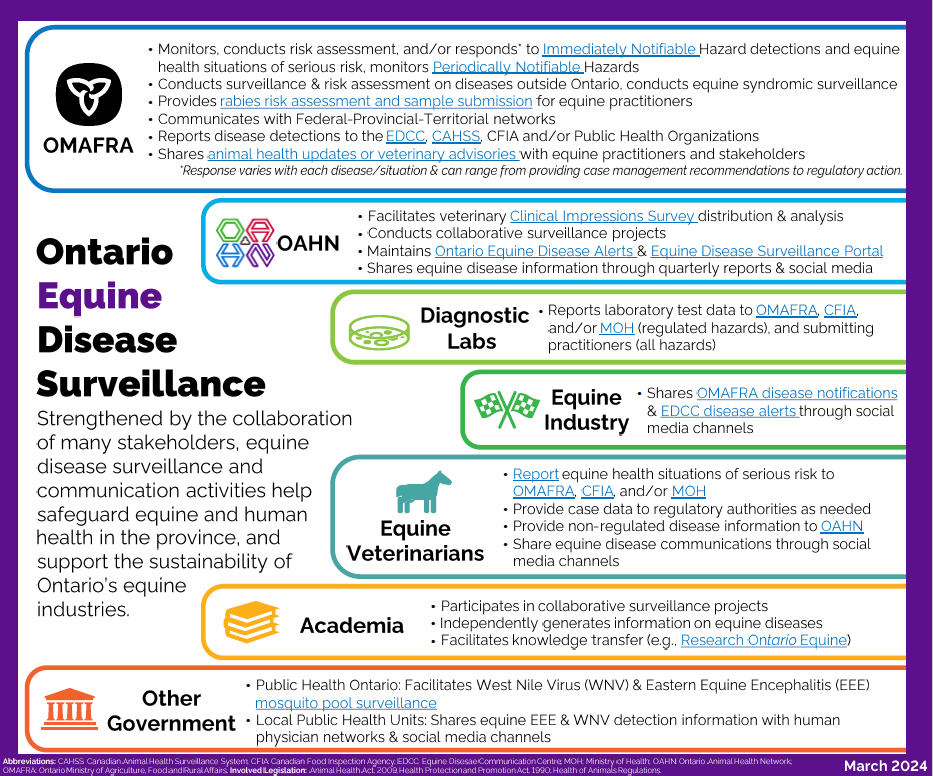
Equine disease surveillance in Ontario is a collaborative effort involving many public and private stakeholders. Diagnostic results generated by veterinary laboratories, clinical impression and case data provided by equine veterinarians, disease detections reported outside of Ontario by independent organizations, vector surveillance conducted by human health agencies, and research projects facilitated by Academic institutions or the Ontario Animal Health Network (OAHN), are all key sources of surveillance data. Strong communication between these stakeholders and with horse owners and caretakers supports both equine and human health in Ontario.
Please follow the links in the summary above for additional information on the associated activities or organizations and for many resources useful to equine industry members.
ResearchONequine.ca is a website developed by the Ontario Animal Health Network equine network to help increase research awareness and to connect researchers from academia, industry and government with the ultimate goal of improving the lives of all equines. It was supported by OAHN and the Ontario Association of Equine Practitioners.
is a website developed by the Ontario Animal Health Network equine network to help increase research awareness and to connect researchers from academia, industry and government with the ultimate goal of improving the lives of all equines. It was supported by OAHN and the Ontario Association of Equine Practitioners.
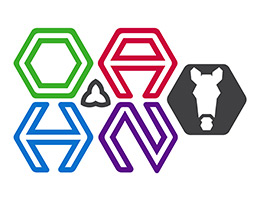



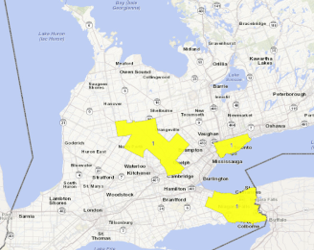 Map of counties with facilities positive for EHV-1 (with EHM) in 2025
Map of counties with facilities positive for EHV-1 (with EHM) in 2025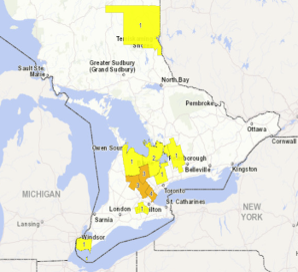 Map of counties with facilities positive for Strangles in 2025.
Map of counties with facilities positive for Strangles in 2025.